Abstract
The inducibility of cytochrome P450 monooxygenases (P450s) and other xenobiotic-metabolizing enzymes is thought to reflect material and energy costs of biosynthesis. Efforts to detect such costs of detoxification enzyme induction, however, have had mixed success. Although they are rarely considered, ecological costs of induction may be a more significant evolutionary constraint on herbivores than material and energy costs. Because some P450-mediated metabolic transformations are bioactivation reactions that increase, rather than reduce, toxicity, maintaining high levels of P450 activity places an organism at risk of greater mortality in the presence of compounds that are bioactivated. We show that P450 inducibility in the generalist moth Helicoverpa zea in response to plant signaling substances, an adaptive response in a ditrophic interaction between herbivore and plant, becomes detrimental in the presence of a third trophic association with a plant pathogen that produces aflatoxin, a toxin that can be bioactivated by P450s. Consumption of plant signaling molecules, such as methyl jasmonate (MeJA) and salicylic acid (SA) enhanced the toxicity of aflatoxin B1 (AFB1) to H. zea that resulted in substantially more damage to larval growth and development. Among the P450 transcripts already cloned from this organism, two in the CYP6B and CYP321A subfamilies are shown to be induced in response to MeJA and SA, suggesting that they may mediate some of the observed bioactivations.





Similar content being viewed by others
References
Agrawal, A. A., Vala, F., and Sabelis, M. W. 2002. Induction of preference and performance after acclimation to novel hosts in a phytophagous spider mite: Adaptive plasticity? Am. Nat. 159:553–565.
Appel, H. M. and Martin, M. M. 1992. Significance of metabolic load in the evolution of host specificity of Manduca sexta. Ecology 73:216–228.
Bi, J. L., Murphy, J. B., and Felton, G. W. 1997. Does salicylic acid act as a signal in cotton for induced resistance to Helicoverpa zea? J. Chem. Ecol. 23:1805–1818.
Brattsten, L. B. 1979. Ecological significance of mixed function oxidations. Drug Metab. Rev. 10:35–58.
Cresswell, J. E., Merritt, S. Z., and Martin, M. M. 1992. The effect of dietary nicotine on the allocation of assimilated food to energy metabolism and growth in fourth-instar larvae of the southern armyworm, Spodoptera eridania (Lepidoptera: Noctuidae). Oecologia 89:449–453.
DeMoraes, C. M., Schultz, J. C., Mescher, M. C., and Tumlinson, J. H. 2004. Induced plant signaling and its implications for environmental sensing. J. Tox. Environ. Health, 67A:819–834.
De Vos, M., Van Oosten, V. R., Poecke, R. M. P., Van Pelt, J. A., Pozo, M. J., Mueller, M. J., et al. 2005. Signal signature and transcriptome changes of Arabidopsis during pathogen and insect attack. Mol. Plant Microbe Interact. 18:923–937.
Dowd, P. F. 1988. Synergism of aflatoxin B1 toxicity with the co-occurring fungal metabolite kojic acid to two caterpillars. Entomol. Exp. Appl. 47:69–71.
Dowd, P. F. 1992. Insect interactions with mytocoxin-producing fungi and their hosts, pp. 137–155, in D. Bhatnagar, E. B. Lillehoj, and D. K. Arora (eds.). Handbook of applied mycology volume 5: Mycotoxins in Ecological Systems. Marcel Dekker, New York.
Dowd, P. F. 1993. Toxicity of the fungal metabolite griseofulvin to Helicoverpa zea and Spodoptera frugiperda. Entomol. Exp. Appl. 69:5–11.
Dowd, P. F. 1998. The involvement of arthropods in the establishment of mycotoxigenic fungi under field conditions, pp. 307–350, in K. K. Sinha and D. Bhatnagar (eds.). Mycotoxins in Agriculture and Food Safety. Marcel Dekker, New York.
Eaton, D. L., Ramsdell, H. S., and Neal, G. E. 1994. Biotransformation of aflatoxins, pp. 45–72, in D. L. Eaton and J. D. Groopman (eds.). The Toxicology of Aflatoxins. Human Health, Veterinary and Agricultural Significance. Academic, London.
Harms, K., Ramirez, I., and Pena-Cortés, H. 1998. Inhibition of wound-induced accumulation of allene oxide synthase transcripts in flax leaves by aspirin and salicylic acid. Plant Physiol. 118:1057–1065.
Heil, M. 2004. Direct defense or ecological costs: Responses of herbivorous beetles to volatiles released by wild lima bean (Phaseolus lunatus). J. Chem. Ecol. 30:1289–1295.
Ioannides, C. 2000. Xenobiotic metabolism and bioactivation by cytochromes P450, pp.103–144, in H. Wiseman, P. Goldfarb, T. Ridgway, and A. Wiseman (eds.). Biomolecular Injury: Causes and Prevention of Toxicity. Wiley, New York.
Iyer, R. S., Vochler, M. W., and Harris, T. M. 1994. Adenine adduct of aflatoxin B 1 epoxide. J. Am. Chem. Soc. 116:8863–8869.
Janzen, D. 1977. Why fruits rot, seeds mold and meat spoils. Am. Nat. 111:691–713.
Kelley, K. C., Johnson, K. S., and Murray, M. 2002. Temporal modulation of pyrrolizidine alkaloid intake and genetic variation in performance of Utetheisa ornatrix caterpillars. J. Chem. Ecol. 28:669–685.
Kessler, A., and Baldwin, I. T. 2002. Plant responses to insect herbivory: The emerging molecular analysis. Annu. Rev. Plant Biol. 53:299–328.
Lee, S. E. and Campbell, B. C. 2000. In vitro metabolism of aflatoxin B1 by larvae of navel orangeworm, Amyelois transitella (Walker) (Insecta, Lepidoptera, Pyralidae) and codling moth, Cydia pomonella (L.) (Insecta, Lepidoptera, Tortricidae). Arch. Insect Biochem. Physiol. 45:166–174.
Li, X., Berenbaum, M. R., and Schuler, M. A. 2002a. Cytochrome P450 and actin genes expressed in Helicoverpa zea and Helicoverpa armigera: paralogy/orthology identification, gene conversion and evolution. Insect Biochem. Mol. Biol. 32:311–320.
Li, X., Schuler, M. A., and Berenbaum, M. R. 2002b. Jasmonate and salicylate induce expression of herbivore cytochrome P450 genes. Nature 419:712–715.
Li, X., Baudry, J., Berenbaum, M. R., and Schuler, M. A. 2004. Structural and functional divergence of insect CYP6B proteins: from specialist to generalist P450. Proc. Natl. Acad. Sci. USA 101:2939–2944.
Lillehoj, E. B. 1992. Aflatoxin genetic mobilization agent, pp.1–22, in D. Bhatnagar, E. B. Lillehoj, and D. K. Arora (eds.). Mycotoxins in Ecological Systems, Handbook of Applied Mycology. Marcel Dekker, New York.
Lou, Y. and Baldwin, I. T. 2004. Nitrogen supply influences herbivore-induced direct and indirect defenses and transcriptional responses in Nicotiana attenuata. Plant Physiol. 135:496–506.
Mewis, I., Appel, H. M., Hom, A., Raina, R., and Schultz, J. C. 2005. Major signalling pathways modulate Arabidopsis glucosinolate accumulation and response to both phloem-feeding and chewing insects. Plant Physiol. 138:1149–1162.
Moran, P. J. and Thompson, G. A. 2001. Molecular responses to aphid feeding in Arabidopsis in relation to plant defense pathways. Plant Physiol. 125:1074–1085.
Murray, R. D. H., Mendez, J., and Brown, S. A. 1982. The Natural Coumarins. Wiley, Chicester, UK.
Neal, J. J. 1987. Metabolic costs of mixed-function oxidase induction in Heliothis zea. Entomol. Exp. Appl. 43:175–179.
Niu, G., Wen, Z., Rupasinghe, S., Zeng, R. S., Berenbaum, M. R., and Schuler, M. A. 2008. Aflatoxin B1 detoxification by CYP321A1 in Helicoverpa zea. Arch. Insect Biochem. Physiol. 68:32–45.
Pechan, T., Ye, L., Chang, Y., Mitra, A., Lin, L., Davis, F. M., et al. 2000. A unique 33-kD cysteine proteinase accumulates in response to larval feeding in maize genotypes resistant to fall armyworm and other Lepidoptera. Plant Cell 12:1031–1040.
Reymond, P., Weber, H., Damond, M., and Farmer, E. E. 2000. Differential gene expression in response to mechanical wounding and insect feeding in Arabidopsis. Plant Cell 12, 707–720.
Reymond, P., Bodenhausen, N., Van Poecke, R. M. P., Krishnamurthy, V., Dicke, M., and Farmer, E. E. 2004. A conserved transcript pattern in response to a specialist and a generalist herbivore. Plant Cell 16:3132–3147.
Royo, J., León, J., Vancanneyt, G., Albar, JP, Rosahl, S., Ortego, F., Castañera, P., and Sánchez-Serrano, J. J. 1999. Antisense-mediated depletion of a potato lipoxygenase reduces wound induction of proteinase inhibitors and increases weight gain of insect pests. Proc. Natl Acad. Sci. USA 96:1146–1151.
Saner, C., Weibel, B., Wurgler, F. E., and Sengstag, C. 1996. Metabolism of promutagens catalyzed by Drosophila melanogaster CYP6A2 enzyme in Saccharomyces cerevisiae. Environ. Environ. Mol. Mutagen. 27:46–58.
Sasabe, M., Wen, Z., Berenbaum, M. R., and Schuler, M. A. 2004. Molecular analysis of CYP321A1, a novel cytochrome P450 involved in metabolism of plant allelochemicals (furanocoumarins) and insecticides (cypermethrin) in Helicoverpa zea. Gene 338:163–175
Seigler, D. S. 1998. Plant Secondary Metabolism. Kluwer, Boston, MA.
Seskar, M., Schulaev, V., and Raskin, I. 1998. Endogenous methyl salicylate in pathogen-inoculated tobacco plants. Plant Physiol. 116:387–392.
Sherratt, T. N., Wilkinson, D. M., and Bain, R. S. 2006. Why fruits rot, seeds mold and meat spoils: a reappraisal. Ecol. Model. 192:618–626.
Stegelmeier, B. L., Edgar, J. A., Colgate, S. M., Gardner, D. R., Schoch, T. K., Coulombe, R. A., and Molyneux, R. J. 1999. Pyrrolizidine alkaloid plants, metabolism and toxicity. J. Nat. Toxins 8:95–116.
Waldbauer, G. P., Cohen, R. W., and Friedman, S. 1984. An improved procedure for laboratory rearing of the corn earworm, Heliothis zea (Lepidoptera: Noctuidae). Great Lakes Entomol. 17:113–118.
Wiseman, B. R. 1999. Corn earworm, pp. 59–61, in K. L. Steffey, M. E. Rice, J. All, D. W. Andow, M. E. Gray, and J. W. Van Duyn (eds.). Handbook of Corn Insects. Entomological Society of America, Lanham, MD.
Yang, Y., Shah, J. and Klessig, D. F. 1997. Signal perception and transduction in plant defense responses. Genes Dev. 11:1621–1639.
Yiannikouris, A. and Jouany, J. P. 2002. Mycotoxins in feeds and their fate in animals: a review. Anim. Res. 51:81–99.
Zeng, R. S., Niu, G., Wen, Z., Schuler, M. A., and Berenbaum, M. R. 2006. Toxicity of aflatoxin B1 to Helicoverpa zea and bioactivation by cytochrome P450 monooxygenases. J. Chem. Ecol. 32:1459–1471.
Acknowledgments
This work was supported by National Science Foundation grant IOB0614726 to M.R.B., National Institutes of Health grant R01 GM071826 to M.A.S., and an UIUC Environmental Toxicology Fellowship to G.N., grants from the National 973 project of China (2006CB100200), Natural Science Foundation of China (30670331, 30870390) and Guangdong (2008B021500001), and Doctoral Program Foundation of the Ministry of Education of China (20060564017) to R.S.Z. We thank Drs. Arthur Zangerl, Jack Schultz, and Patrick Dowd for comments on the manuscript and Allen Lawrence and Henan Zeng for assistance with insect rearing.
Author information
Authors and Affiliations
Corresponding authors
Rights and permissions
About this article
Cite this article
Zeng, R.S., Wen, Z., Niu, G. et al. Enhanced Toxicity and Induction of Cytochrome P450s Suggest a Cost of “Eavesdropping” in a Multitrophic Interaction. J Chem Ecol 35, 526–532 (2009). https://doi.org/10.1007/s10886-009-9640-6
Received:
Revised:
Accepted:
Published:
Issue Date:
DOI: https://doi.org/10.1007/s10886-009-9640-6




